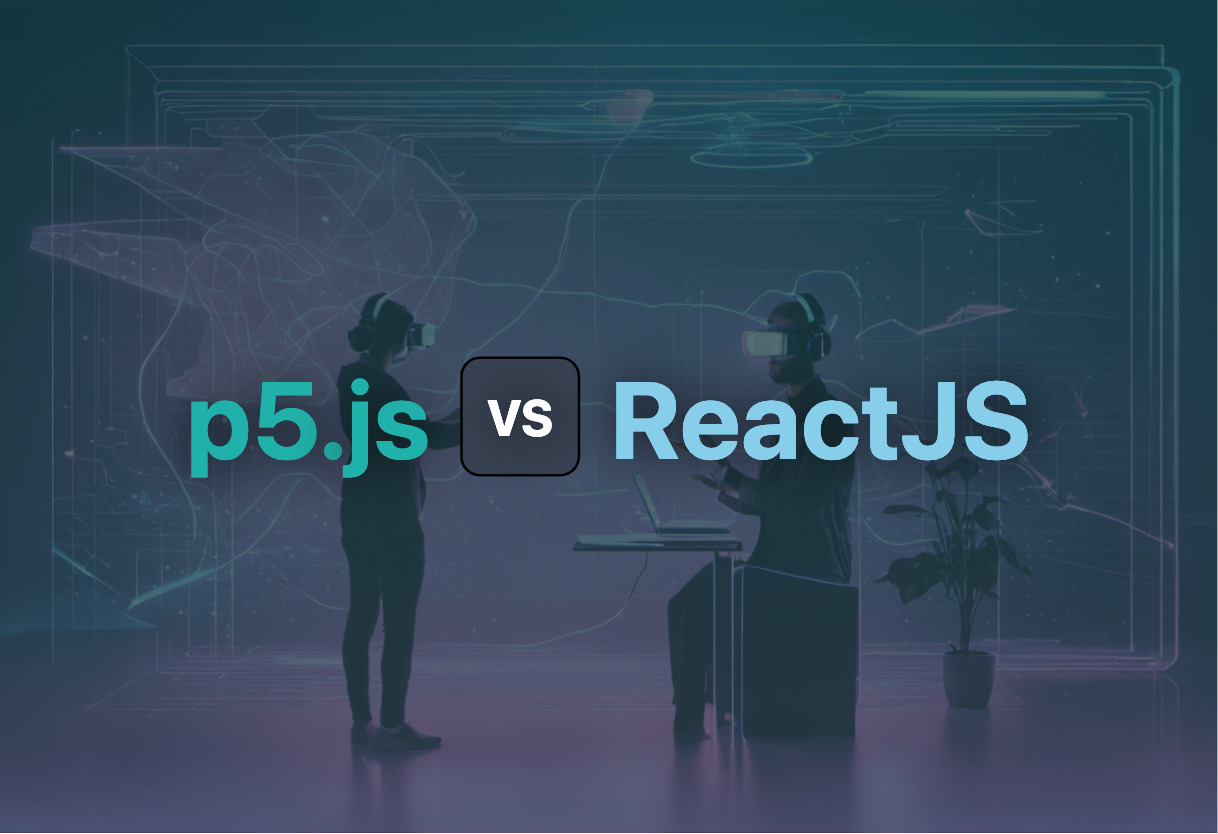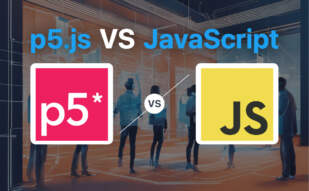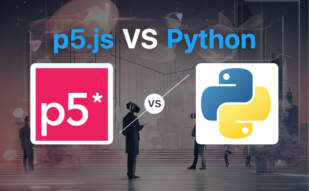If you’re an artist or educator targeting visual programming, simplified GUI, and cross-platform capabilities, p5.js would be your ideal choice. However, ReactJS would be superb for dynamic, interactive web/mobile app UI/UX design, with an open-source, component-based structure and JavaScript-HTML synergies.

Key Differences Between p5.js and ReactJS
- p5.js focuses on visual programming, teaching non-programmers, and GUI, while ReactJS enables dynamic, interactive UI/UX design for web/mobile apps.
- p5.js features a Java-based toolkit and language, despite Python and JavaScript options and Processing.js’ JavaScript port. ReactJS integrates HTML with JavaScript via JSX, enhancing readability and simplification.
- While p5.js maintains cross-platform compatibility, ReactJS ensures strong performance via Virtual DOM and One-way Data Binding features.
- ReactJS is maintained and improved by Facebook’s developer community, while p5.js was initiated by the Processing Foundation and has smaller projects internationally.
| Comparison | p5.js | ReactJS |
|---|---|---|
| Initial Release | 2001 | 2011 |
| Stable Release | 4.3 – July 26, 2023 | Version 17.0.1 |
| License | GPL, LGPL | Open-source |
| Usage | Visual design, teaching non-programmers computer programming | Building dynamic, interactive applications for better UI/UX design |
| Development Language | Java | JavaScript |
| Major Features | Visual context, Graphical user interface, No standard data type limitation | JSX, Virtual DOM, Simplicity, One-Way Data Binding, Performance |
| Supported Platforms | Cross-platform | Web, Mobile |
| Main Contributors | Casey Reas, Ben Fry, Daniel Shiffman, Johanna Hedva | Jordan Walke |
| Community Support | Processing Foundation |
What Is p5.js and Who’s It For?
p5.js is a JavaScript library that aids in the teaching of computer programming in a visual context. Initiated by Casey Reas and Ben Fry in 2001 at the MIT Media Lab, it is a tool for visual design and arts. It was designed with simplifications for easy understanding and use to make programming accessible and interesting for beginners and non-programmers.
p5.js is for everyone who desires to learn programming, especially in a visual context. It’s ideal for educators, students, and beginners in programming who value a user-friendly interface, as well as artists and designers that want to create interactive digital artworks.
Pros of p5.js
- Easy to learn, especially for beginners.
- Offers a visual context, making learning interactive and fun.
- Supported by a robust community and extensive resources for learning.
Cons of p5.js
- Not as powerful as some other JavaScript libraries.
- Could be limiting for advanced coders.
What Is ReactJS and Who’s It For?
ReactJS is an open-source, component-based JavaScript library created by Facebook for developing dynamic, interactive web and mobile apps. It was crafted to build UI/UX design with ease, efficiency and a high level of performance.
ReactJS is intended for web developers and programmers who need a scalable, efficient, and powerful tool for creating interactive UIs for web and mobile apps. It’s equally beneficial for start-ups and established enterprises needing to develop high-performance apps in a time-effective manner.
Pros of ReactJS
- Highly efficient due to its Virtual DOM feature.
- Easy-to-understand coding with JSX.
- Strong community support and extensive resources for learning.
Cons of ReactJS
- JSX syntax could be complex for beginners.
- Dynamic nature might lead to frequent updates.
p5.js vs ReactJS: Pricing
Both p5.js and ReactJS are open-source tools, making them free for all developers to leverage.
p5.js
As an open-source project, p5.js operates under GNU General Public licenses (GPL, LGPL). This means it’s freely available to any individual or organization. No subscription fees, no payment tiers, and no hidden costs. Its aim is to encourage widespread adoption and foster a global community of developers committed to innovation.
ReactJS
ReactJS, developed by Facebook, also basks in the unquestionable benefits of open-source. Similarly, it doesn’t entail any cost for usage. Built and maintained by Facebook and a community of individual developers and companies, ReactJS endorses the open-source philosophy, promoting collaboration, transparency, and rapid evolution at no financial burden to developers.
Code Examples for p5.js & ReactJS
p5.js
This p5.js code creates an interactive sketch depicting a pulsating star. The star’s radiating spikes react to the mouse position, varying in number as the cursor moves. The necessary prerequisite is a basic understanding of p5 functions such as setup() and draw().
let n = 0;
function setup() {
createCanvas(720, 400);
noStroke();
fill(204, 120);
}
function draw() {
background(0);
n = map(mouseX, 0, width, 0, 10);
for(let i = 0; i < 60; i++) {
let sz = i * 12;
let angle = TWO_PI / n * i;
let px = width / 2 + cos(angle) * sz;
let py = height / 2 + sin(angle) * sz;
ellipse(px, py, 5, 5);
}
}ReactJS
This ReactJS code features a functional component showcasing a simple counter application. Interactivity via buttons either increments or decrements the displayed value. Prior knowledge of React, state hooks, and event handlers will ensure the code performs seamlessly.
import React, { useState } from 'react';
function Counter() {
const [count, setCount] = useState(0);
return (
<div>
<p>You clicked {count} times</p>
<button onclick="{()" ==""> setCount(count + 1)}>
Click me to increment
</button>
<button onclick="{()" ==""> setCount(count - 1)}>
Click me to decrement
</button>
</div>
);
}
export default Counter;p5.js or ReactJS: The Final Choice
To choose between p5.js and ReactJS, your decision hinges on utility, preference and project requirements.
AR/VR & Game Developers
For those creating interactive art, prototyping products, or developing games, especially for web browsers, p5.js stands as a worthy contender. Its foundation upon Processing offers a graphical context, making it excellent for rendering visual content, inclusive of 2D and 3D content.

Non-Programmers & Newbies to Coding
The simplified, visual context of p5.js is ideally suited for non-programmers and new entrants to the programming universe. User-friendly, it allows convenient creation of classes in its PApplet sketch, and there’s no standard limitation on data type usage.

Dynamic Interactive Application Developers
If your primary goal is crafting dynamic, interactive applications for web or mobile, ReactJS is a no-brainer. Boasting a virtual DOM, one-way data binding, JSX for code simplification, and an array of extensions, it excels at UI design and performance.

High-Performance Web App Developers
Aiming for fast, optimized web applications? Choose ReactJS. With its virtual DOM delivering boosts to performance and React’s ability to offer SEO-friendly server-side rendering, it’s the ideal choice for high-quality web applications.

In a nutshell: p5.js serves art, game development, and beginners perfectly, with simplicity and a visual context. ReactJS thrives in the realms of dynamic, interactive applications, offering robust UI design and high-performance web applications. Choose your tool wisely.
Grant Sullivan
Content writer @ Aircada and self proclaimed board game strategist by day, AI developer by night.





